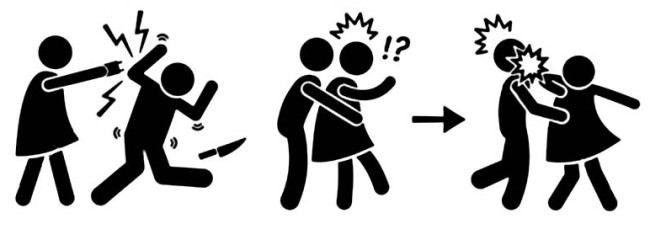I recently watched some of the TV series, “Kung-Fu” (1972-75) with my young son. It was my favorite when I was a teenager. The show’s hero, Kawi Chang Caine, never used force other than defensively. And if the issue could be solved without force, he took that route. A good role model.
In one episode, a Shaolin master told students the best defense was to run. Implicit in his instruction was, “…but only if you can do so safely”. Another good standard, and a match for NY law. I hope my son was paying attention.
In the face of illegal violence, the goal is to avoid harm, not to prove yourself the better fighter. There are times, however, when running is not an option. Maybe you are with someone who needs your protection, or turning your back would tactically be a dangerous move.
The use of physical force is allowed in NY under the doctrine of “justification”. Justification does not excuse an otherwise criminal act. The law acknowledges the use force is lawful under certain circumstances. But when in a public place, there is a duty to retreat before using force if—and only if— retreating can be done safely.
There is no duty to retreat in one’s home or in a dwelling you are rightfully in. You are not required to run out the back door when a burglar comes in the front. Known as the “Castle Doctrine” in some areas (as in “a person’s home is their castle”), the law allows you to stand firm in your home against illegal force. But you are still required to use only “reasonable” force in defense. As they say, the devil is in the details. What is reasonable? The answer will depend upon the facts and persons involved in each case.
Reasonable force is that degree of force which is enough to counter the illegal force being directed against you. It must be proportionate to the threat. Unreasonable force can be obvious, as in the Monty Python skit about the hunter fighting mosquitoes with a bazooka. Other cases can be closer calls.
You can’t use deadly force to respond to “ordinary” (non-deadly) force. Deadly force is that which is capable of killing or causing crippling injury. In order to use deadly force in self-defense, you must have a reasonable belief you are in imminent danger of suffering death or grave bodily injury (same applies to your defense of other innocents). The attacker must have the ability and opportunity to inflict death or grave bodily harm, and you must be in immediate jeopardy.
Next time, we will go into detail and I will give examples of some cases. By now, I’m sure you see how one topic easily leads to another, and to another…
Due to time constraints, law school only covers some areas superficially. Criminal law is just one course, and justification is only a small part of the subject. Fortunately, there are those who have made this their life’s study and have shared their expertise with defense lawyers, prosecutors, law enforcement, and law abiding citizens.
The person who I have studied the subject of defensive use of force with is Massad Ayoob. He is a pioneer in this field. His expertise has been recognized by courts across our nation. He served for 30 years as a police officer, has published books, hundreds of articles, taught thousands of students, and served as co-chair of the Forensic Evidence Committee for the National Association of Criminal Defense Lawyers. Yes….defense lawyers love this guy just as much as cops do. That speaks volumes. I am grateful for everything I have learned (and continue to learn) from him. His latest book is Deadly Force—Understanding Your Right to Self Defense (available on Amazon and other outlets).


夢巴黎春藥網:https://pariss88.com/
女性催情春藥:https://pariss88.com/product-category/aphrodisiac/
女性迷幻春藥:https://pariss88.com/product-category/psychedelic/
印度正品代購:https://pariss88.com/product-category/medicine/
男性壯陽補腎:https://pariss88.com/product-category/kidney/
陰莖增大增粗:https://pariss88.com/product-category/thicken/
GB系列春藥:https://pariss88.com/product-category/aroused/
所有春藥商品:https://pariss88.com/shop/
春藥資訊:https://pariss88.com/blog/
關於我們:https://pariss88.com/about-us
Reply春藥對女性性慾望的顯著增強作用!
春藥是最受歡迎的女性催情藥物,讓愛火重燃的秘密武器!
春藥是什麼?揭開女性催情藥的神秘面紗
春藥如何影響女性性反應?揭開春藥的實際效果
春藥會讓人上癮嗎?揭開女性催情藥的真實效果與安全性
春藥效果解析:提升女性性慾與性愛滿意度的秘密武器
春藥對女性身體的深層影響:從血液循環到極致快感的全面解析
春藥的效果與作用:提升女性性慾望與性滿意度
春藥效果與作用全面解析:激發女性性慾與改善性冷淡
春藥是激發女性性慾望及提升性高潮快感的秘密武器
春藥的催情效果全解析:讓性愛更激情性高潮更猛烈
春藥效果大揭密:找回激情性愛的秘密武器!
女性服用春藥後的真實反應:從羞澀到淫蕩發騷的轉變
春藥如何幫助女性體驗激情性愛:全面指南
春藥:點燃女性激情,體驗極致性愛享受的秘訣
春藥如何通過刺激女性荷爾蒙來增強性快感?
春藥如何幫助女性找回激情性愛,享受極致快感?
春藥如何激發女性淫蕩慾望,讓女性主動求愛的?
春藥在兩性關係中起到哪些作用?解析春藥的效果
春藥在性愛中的關鍵作用:釋放女性淫蕩慾望
春藥如何讓女性淫蕩發情主動求歡:全面解析春藥效果
春藥如何幫助女性重燃性愛激情體驗美妙性高潮?
春藥的神奇效果:從淑女到淫蕩發騷的轉變
春藥的催情效果:讓女性在性愛中欲仙欲死的極致體驗
春藥的效果:激發女性性慾望的深度解析
春藥番外篇:天然春藥與合成春藥的效果對比
Reply春藥
媚藥
催情春藥
催情藥
女性春藥
春藥哪裡買
春藥推薦
春藥是什麼
春藥水
有效春藥
正品春藥
無色無味的春藥
網購春藥
進口春藥
女性媚藥
日本媚藥
日本春藥
春藥真的有用嗎
春藥有副作用嗎
催淫春藥
春藥膠囊
粉狀春藥
液體春藥
昏睡春藥
迷情春藥
迷幻春藥
催眠春藥
口交水
聽話水
乖乖水
失憶水
催情水
迷姦水
迷姦藥
迷幻藥
高潮液
催情液
春藥粉
女性發騷水
淫蕩發騷春藥
女性催淫春藥
激發女性性慾
增強性快感
增加女性主動
增加女性分泌物
增加女性敏感度
治療女性性冷淡
誘發女性性渴望
事後無記憶
迷幻催情春藥
昏睡失憶春藥
強效催情春藥
女性淫蕩發騷
女性催情膠囊
無副作用春藥
女性潮吹春藥
男女通用型春藥
催情口服液
無色無味的春藥
催情春藥水
女性催情媚藥
昏睡迷姦春藥
無色無味春藥水
超強淫蕩媚藥
女性外用春藥
刺激陰蒂快感
女性催情高潮液
女性私處高潮液
女性高潮潤滑劑
女用催淫凝膠
強效催情凝膠
發騷春藥凝膠
Reply